BUS707 Applied Business Research: Analysis of Audit Report Changes
VerifiedAdded on 2023/06/11
|24
|5897
|426
Report
AI Summary
This report provides an analysis of the key changes in audit report requirements, focusing on the International Standards on Auditing (ISA) and their implications for Australian businesses. It examines the reasons for these changes, including the need for increased transparency and reliability in financial reporting, particularly in response to concerns raised by the international investment community. The report identifies specific changes to ISA standards and discusses the expected benefits, such as improved communication between auditors and stakeholders, enhanced corporate governance, and increased professional skepticism. Furthermore, it explores the impact of these changes on financial reporting practices and highlights key enhancements, including the communication of key audit matters and improved reporting on going concern. The research methodology employs epistemology philosophy and exploratory study techniques, utilizing both primary and secondary data sources while adhering to ethical considerations. This assignment is available on Desklib, a platform offering a wealth of study resources for students.
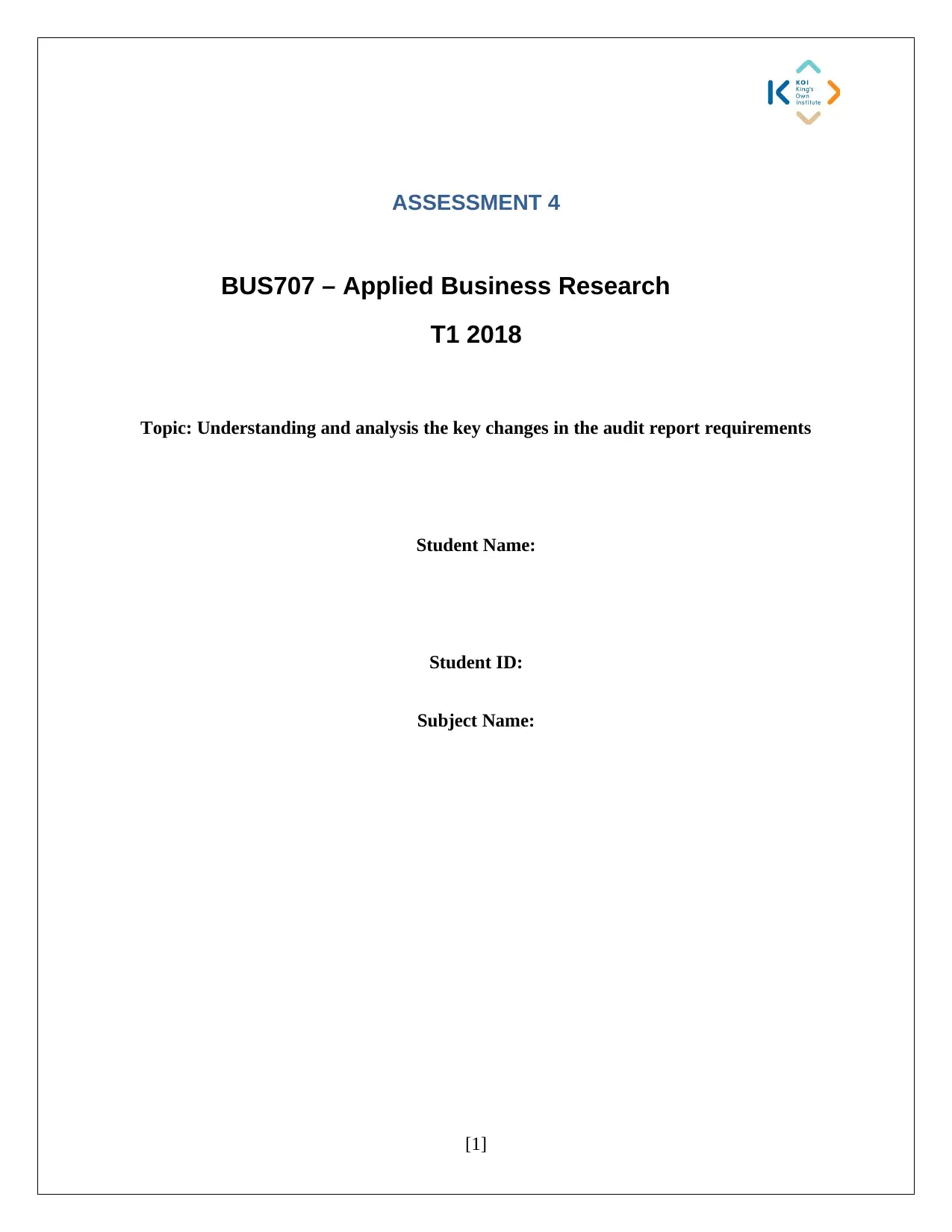
ASSESSMENT 4
BUS707 – Applied Business Research
T1 2018
Topic: Understanding and analysis the key changes in the audit report requirements
Student Name:
Student ID:
Subject Name:
[1]
BUS707 – Applied Business Research
T1 2018
Topic: Understanding and analysis the key changes in the audit report requirements
Student Name:
Student ID:
Subject Name:
[1]
Paraphrase This Document
Need a fresh take? Get an instant paraphrase of this document with our AI Paraphraser
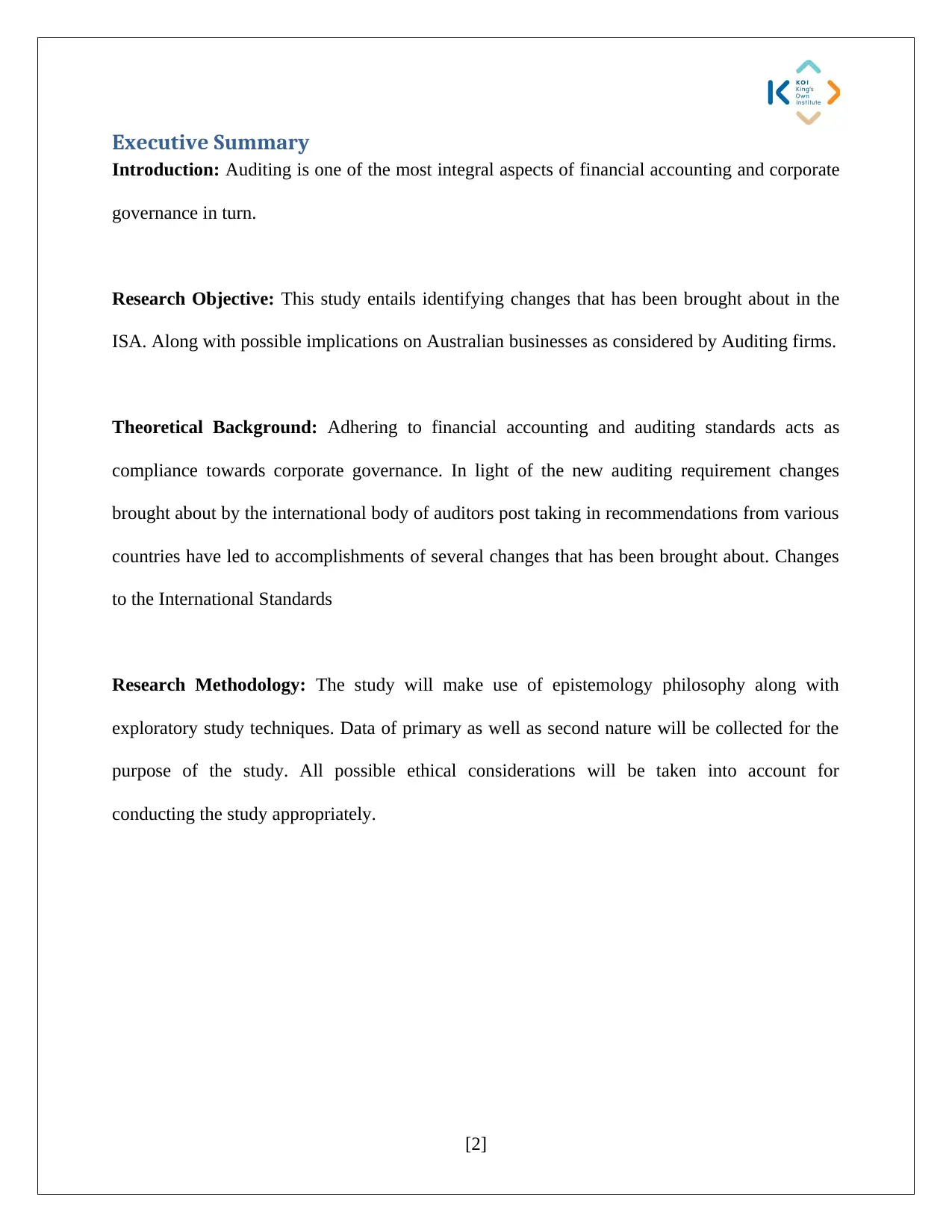
Executive Summary
Introduction: Auditing is one of the most integral aspects of financial accounting and corporate
governance in turn.
Research Objective: This study entails identifying changes that has been brought about in the
ISA. Along with possible implications on Australian businesses as considered by Auditing firms.
Theoretical Background: Adhering to financial accounting and auditing standards acts as
compliance towards corporate governance. In light of the new auditing requirement changes
brought about by the international body of auditors post taking in recommendations from various
countries have led to accomplishments of several changes that has been brought about. Changes
to the International Standards
Research Methodology: The study will make use of epistemology philosophy along with
exploratory study techniques. Data of primary as well as second nature will be collected for the
purpose of the study. All possible ethical considerations will be taken into account for
conducting the study appropriately.
[2]
Introduction: Auditing is one of the most integral aspects of financial accounting and corporate
governance in turn.
Research Objective: This study entails identifying changes that has been brought about in the
ISA. Along with possible implications on Australian businesses as considered by Auditing firms.
Theoretical Background: Adhering to financial accounting and auditing standards acts as
compliance towards corporate governance. In light of the new auditing requirement changes
brought about by the international body of auditors post taking in recommendations from various
countries have led to accomplishments of several changes that has been brought about. Changes
to the International Standards
Research Methodology: The study will make use of epistemology philosophy along with
exploratory study techniques. Data of primary as well as second nature will be collected for the
purpose of the study. All possible ethical considerations will be taken into account for
conducting the study appropriately.
[2]
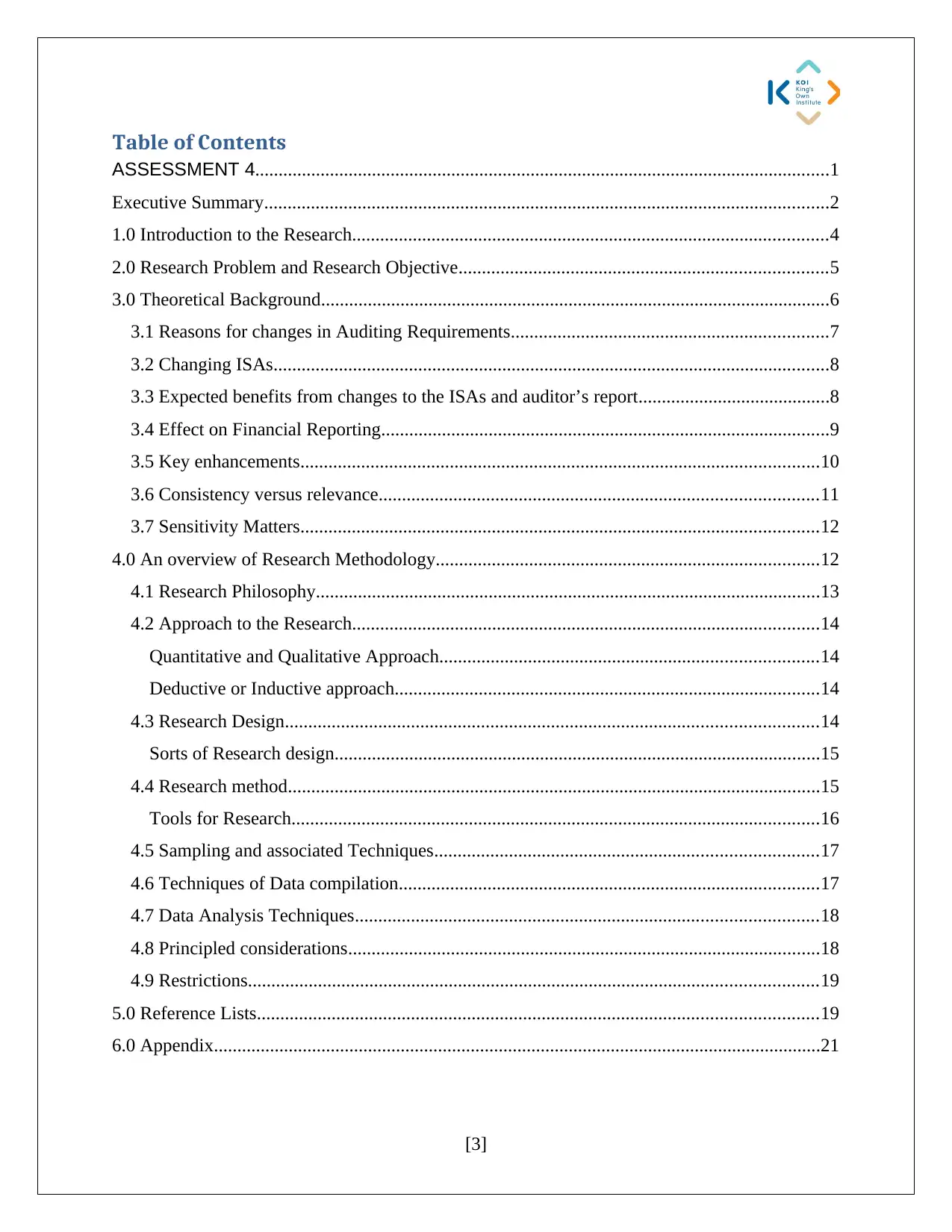
Table of Contents
ASSESSMENT 4...........................................................................................................................1
Executive Summary.........................................................................................................................2
1.0 Introduction to the Research......................................................................................................4
2.0 Research Problem and Research Objective...............................................................................5
3.0 Theoretical Background.............................................................................................................6
3.1 Reasons for changes in Auditing Requirements....................................................................7
3.2 Changing ISAs.......................................................................................................................8
3.3 Expected benefits from changes to the ISAs and auditor’s report.........................................8
3.4 Effect on Financial Reporting................................................................................................9
3.5 Key enhancements...............................................................................................................10
3.6 Consistency versus relevance..............................................................................................11
3.7 Sensitivity Matters...............................................................................................................12
4.0 An overview of Research Methodology..................................................................................12
4.1 Research Philosophy............................................................................................................13
4.2 Approach to the Research....................................................................................................14
Quantitative and Qualitative Approach.................................................................................14
Deductive or Inductive approach...........................................................................................14
4.3 Research Design..................................................................................................................14
Sorts of Research design........................................................................................................15
4.4 Research method..................................................................................................................15
Tools for Research.................................................................................................................16
4.5 Sampling and associated Techniques..................................................................................17
4.6 Techniques of Data compilation..........................................................................................17
4.7 Data Analysis Techniques...................................................................................................18
4.8 Principled considerations.....................................................................................................18
4.9 Restrictions..........................................................................................................................19
5.0 Reference Lists........................................................................................................................19
6.0 Appendix..................................................................................................................................21
[3]
ASSESSMENT 4...........................................................................................................................1
Executive Summary.........................................................................................................................2
1.0 Introduction to the Research......................................................................................................4
2.0 Research Problem and Research Objective...............................................................................5
3.0 Theoretical Background.............................................................................................................6
3.1 Reasons for changes in Auditing Requirements....................................................................7
3.2 Changing ISAs.......................................................................................................................8
3.3 Expected benefits from changes to the ISAs and auditor’s report.........................................8
3.4 Effect on Financial Reporting................................................................................................9
3.5 Key enhancements...............................................................................................................10
3.6 Consistency versus relevance..............................................................................................11
3.7 Sensitivity Matters...............................................................................................................12
4.0 An overview of Research Methodology..................................................................................12
4.1 Research Philosophy............................................................................................................13
4.2 Approach to the Research....................................................................................................14
Quantitative and Qualitative Approach.................................................................................14
Deductive or Inductive approach...........................................................................................14
4.3 Research Design..................................................................................................................14
Sorts of Research design........................................................................................................15
4.4 Research method..................................................................................................................15
Tools for Research.................................................................................................................16
4.5 Sampling and associated Techniques..................................................................................17
4.6 Techniques of Data compilation..........................................................................................17
4.7 Data Analysis Techniques...................................................................................................18
4.8 Principled considerations.....................................................................................................18
4.9 Restrictions..........................................................................................................................19
5.0 Reference Lists........................................................................................................................19
6.0 Appendix..................................................................................................................................21
[3]
⊘ This is a preview!⊘
Do you want full access?
Subscribe today to unlock all pages.

Trusted by 1+ million students worldwide
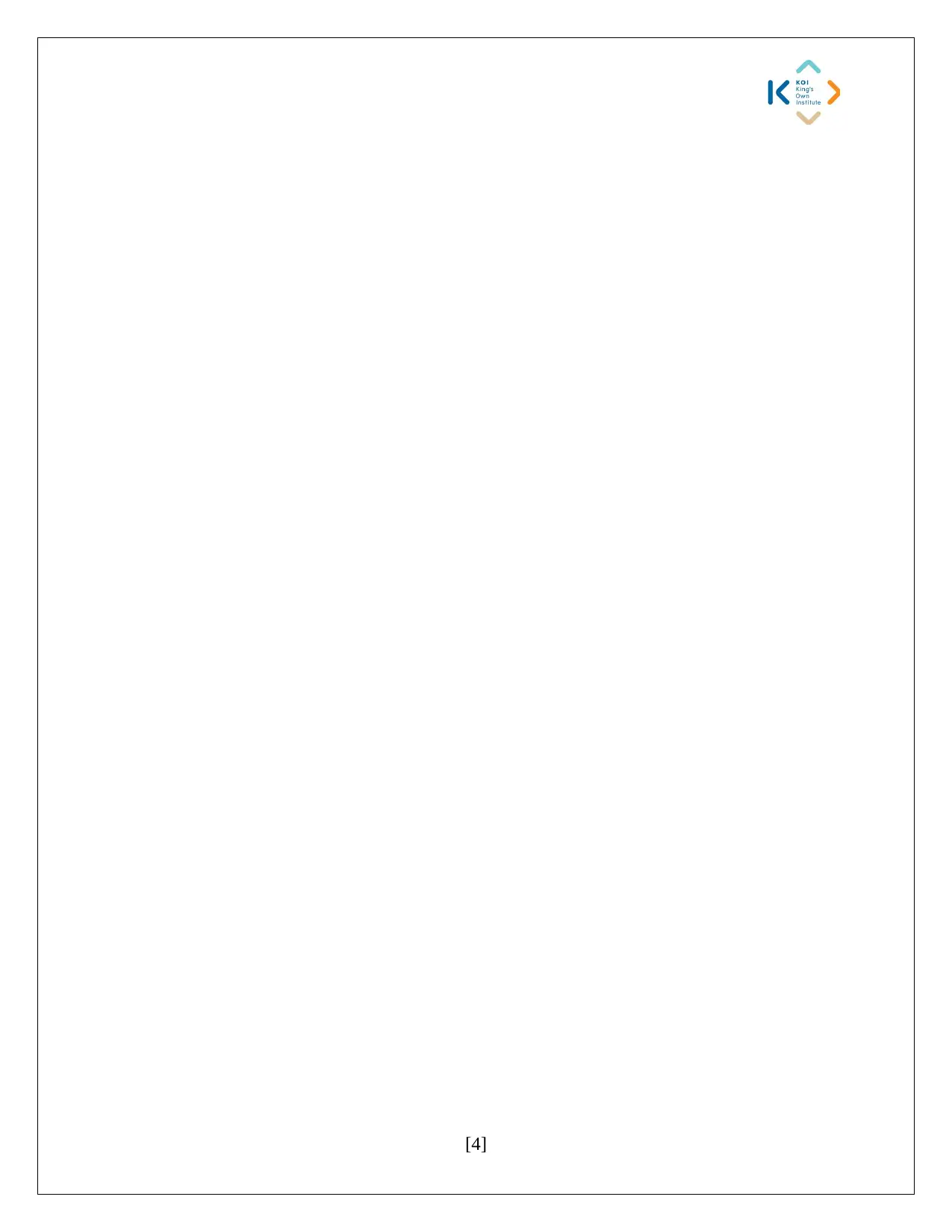
[4]
Paraphrase This Document
Need a fresh take? Get an instant paraphrase of this document with our AI Paraphraser
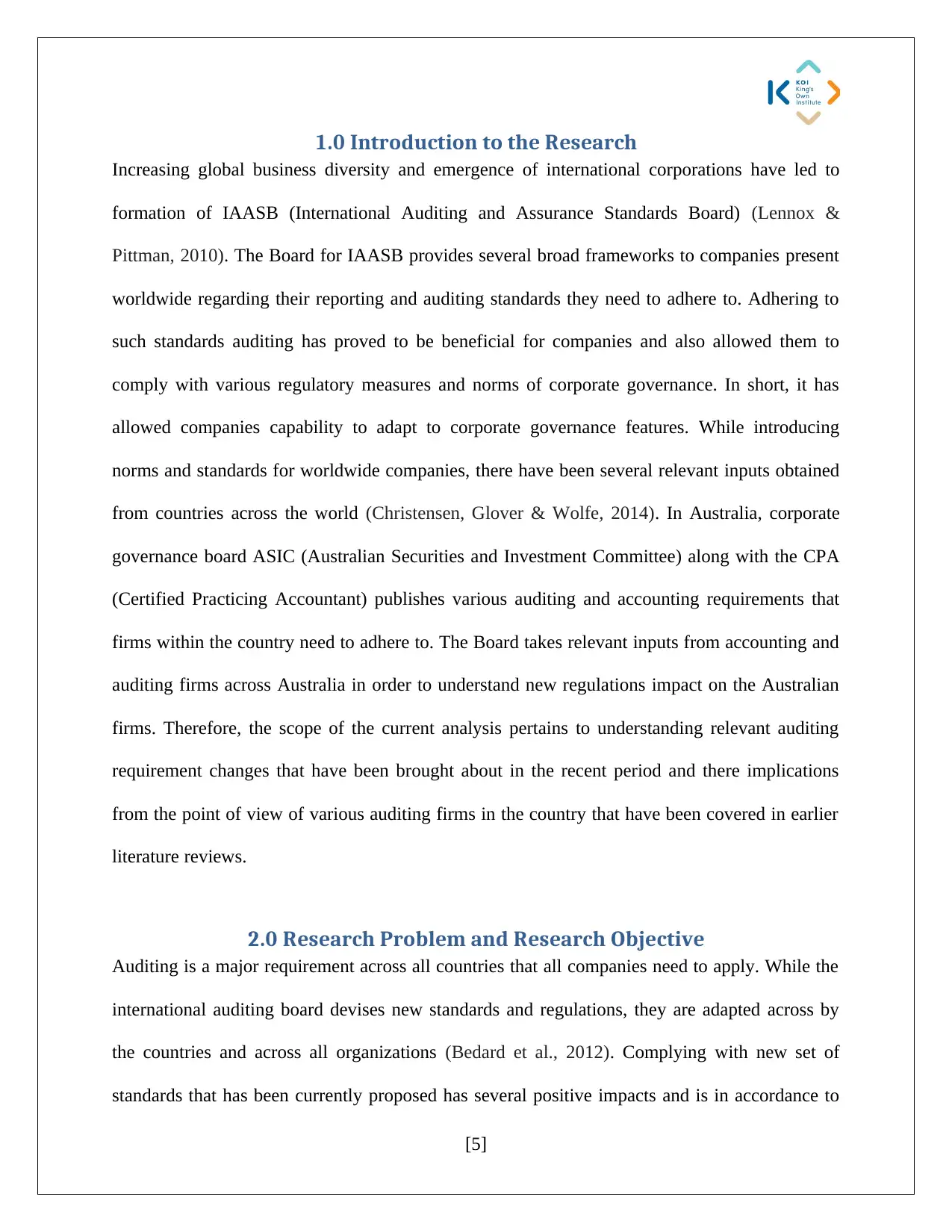
1.0 Introduction to the Research
Increasing global business diversity and emergence of international corporations have led to
formation of IAASB (International Auditing and Assurance Standards Board) (Lennox &
Pittman, 2010). The Board for IAASB provides several broad frameworks to companies present
worldwide regarding their reporting and auditing standards they need to adhere to. Adhering to
such standards auditing has proved to be beneficial for companies and also allowed them to
comply with various regulatory measures and norms of corporate governance. In short, it has
allowed companies capability to adapt to corporate governance features. While introducing
norms and standards for worldwide companies, there have been several relevant inputs obtained
from countries across the world (Christensen, Glover & Wolfe, 2014). In Australia, corporate
governance board ASIC (Australian Securities and Investment Committee) along with the CPA
(Certified Practicing Accountant) publishes various auditing and accounting requirements that
firms within the country need to adhere to. The Board takes relevant inputs from accounting and
auditing firms across Australia in order to understand new regulations impact on the Australian
firms. Therefore, the scope of the current analysis pertains to understanding relevant auditing
requirement changes that have been brought about in the recent period and there implications
from the point of view of various auditing firms in the country that have been covered in earlier
literature reviews.
2.0 Research Problem and Research Objective
Auditing is a major requirement across all countries that all companies need to apply. While the
international auditing board devises new standards and regulations, they are adapted across by
the countries and across all organizations (Bedard et al., 2012). Complying with new set of
standards that has been currently proposed has several positive impacts and is in accordance to
[5]
Increasing global business diversity and emergence of international corporations have led to
formation of IAASB (International Auditing and Assurance Standards Board) (Lennox &
Pittman, 2010). The Board for IAASB provides several broad frameworks to companies present
worldwide regarding their reporting and auditing standards they need to adhere to. Adhering to
such standards auditing has proved to be beneficial for companies and also allowed them to
comply with various regulatory measures and norms of corporate governance. In short, it has
allowed companies capability to adapt to corporate governance features. While introducing
norms and standards for worldwide companies, there have been several relevant inputs obtained
from countries across the world (Christensen, Glover & Wolfe, 2014). In Australia, corporate
governance board ASIC (Australian Securities and Investment Committee) along with the CPA
(Certified Practicing Accountant) publishes various auditing and accounting requirements that
firms within the country need to adhere to. The Board takes relevant inputs from accounting and
auditing firms across Australia in order to understand new regulations impact on the Australian
firms. Therefore, the scope of the current analysis pertains to understanding relevant auditing
requirement changes that have been brought about in the recent period and there implications
from the point of view of various auditing firms in the country that have been covered in earlier
literature reviews.
2.0 Research Problem and Research Objective
Auditing is a major requirement across all countries that all companies need to apply. While the
international auditing board devises new standards and regulations, they are adapted across by
the countries and across all organizations (Bedard et al., 2012). Complying with new set of
standards that has been currently proposed has several positive impacts and is in accordance to
[5]
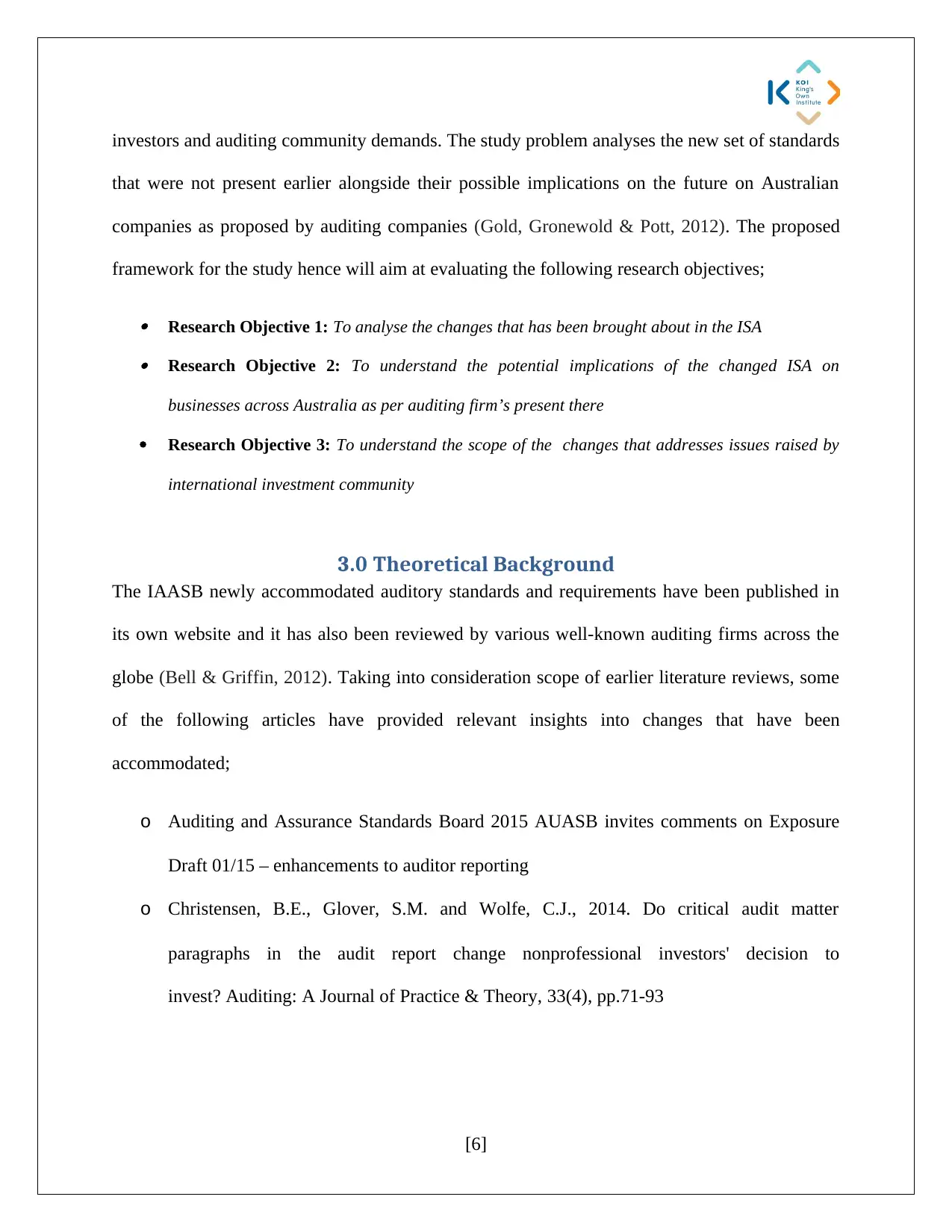
investors and auditing community demands. The study problem analyses the new set of standards
that were not present earlier alongside their possible implications on the future on Australian
companies as proposed by auditing companies (Gold, Gronewold & Pott, 2012). The proposed
framework for the study hence will aim at evaluating the following research objectives;
Research Objective 1: To analyse the changes that has been brought about in the ISA Research Objective 2: To understand the potential implications of the changed ISA on
businesses across Australia as per auditing firm’s present there
Research Objective 3: To understand the scope of the changes that addresses issues raised by
international investment community
3.0 Theoretical Background
The IAASB newly accommodated auditory standards and requirements have been published in
its own website and it has also been reviewed by various well-known auditing firms across the
globe (Bell & Griffin, 2012). Taking into consideration scope of earlier literature reviews, some
of the following articles have provided relevant insights into changes that have been
accommodated;
o Auditing and Assurance Standards Board 2015 AUASB invites comments on Exposure
Draft 01/15 – enhancements to auditor reporting
o Christensen, B.E., Glover, S.M. and Wolfe, C.J., 2014. Do critical audit matter
paragraphs in the audit report change nonprofessional investors' decision to
invest? Auditing: A Journal of Practice & Theory, 33(4), pp.71-93
[6]
that were not present earlier alongside their possible implications on the future on Australian
companies as proposed by auditing companies (Gold, Gronewold & Pott, 2012). The proposed
framework for the study hence will aim at evaluating the following research objectives;
Research Objective 1: To analyse the changes that has been brought about in the ISA Research Objective 2: To understand the potential implications of the changed ISA on
businesses across Australia as per auditing firm’s present there
Research Objective 3: To understand the scope of the changes that addresses issues raised by
international investment community
3.0 Theoretical Background
The IAASB newly accommodated auditory standards and requirements have been published in
its own website and it has also been reviewed by various well-known auditing firms across the
globe (Bell & Griffin, 2012). Taking into consideration scope of earlier literature reviews, some
of the following articles have provided relevant insights into changes that have been
accommodated;
o Auditing and Assurance Standards Board 2015 AUASB invites comments on Exposure
Draft 01/15 – enhancements to auditor reporting
o Christensen, B.E., Glover, S.M. and Wolfe, C.J., 2014. Do critical audit matter
paragraphs in the audit report change nonprofessional investors' decision to
invest? Auditing: A Journal of Practice & Theory, 33(4), pp.71-93
[6]
⊘ This is a preview!⊘
Do you want full access?
Subscribe today to unlock all pages.

Trusted by 1+ million students worldwide
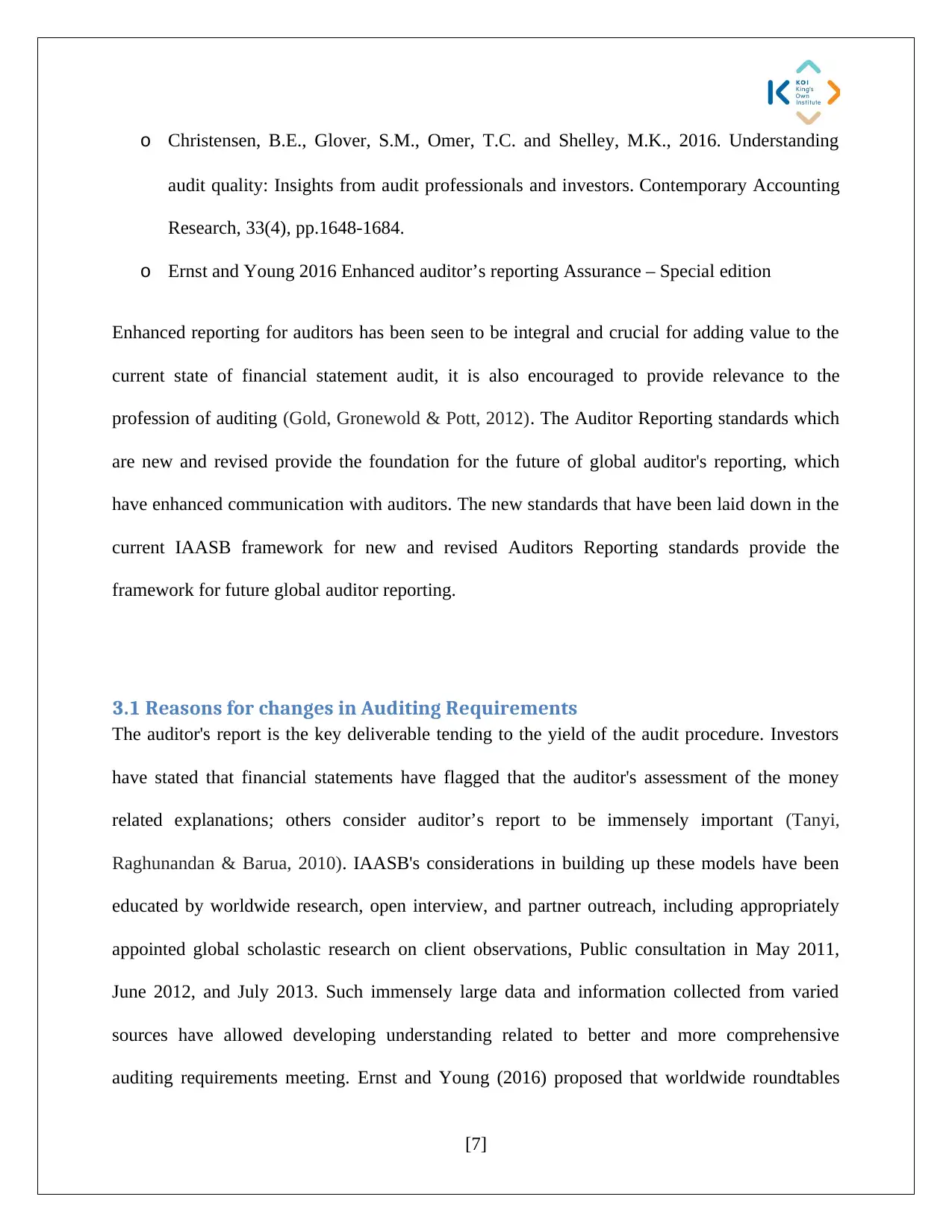
o Christensen, B.E., Glover, S.M., Omer, T.C. and Shelley, M.K., 2016. Understanding
audit quality: Insights from audit professionals and investors. Contemporary Accounting
Research, 33(4), pp.1648-1684.
o Ernst and Young 2016 Enhanced auditor’s reporting Assurance – Special edition
Enhanced reporting for auditors has been seen to be integral and crucial for adding value to the
current state of financial statement audit, it is also encouraged to provide relevance to the
profession of auditing (Gold, Gronewold & Pott, 2012). The Auditor Reporting standards which
are new and revised provide the foundation for the future of global auditor's reporting, which
have enhanced communication with auditors. The new standards that have been laid down in the
current IAASB framework for new and revised Auditors Reporting standards provide the
framework for future global auditor reporting.
3.1 Reasons for changes in Auditing Requirements
The auditor's report is the key deliverable tending to the yield of the audit procedure. Investors
have stated that financial statements have flagged that the auditor's assessment of the money
related explanations; others consider auditor’s report to be immensely important (Tanyi,
Raghunandan & Barua, 2010). IAASB's considerations in building up these models have been
educated by worldwide research, open interview, and partner outreach, including appropriately
appointed global scholastic research on client observations, Public consultation in May 2011,
June 2012, and July 2013. Such immensely large data and information collected from varied
sources have allowed developing understanding related to better and more comprehensive
auditing requirements meeting. Ernst and Young (2016) proposed that worldwide roundtables
[7]
audit quality: Insights from audit professionals and investors. Contemporary Accounting
Research, 33(4), pp.1648-1684.
o Ernst and Young 2016 Enhanced auditor’s reporting Assurance – Special edition
Enhanced reporting for auditors has been seen to be integral and crucial for adding value to the
current state of financial statement audit, it is also encouraged to provide relevance to the
profession of auditing (Gold, Gronewold & Pott, 2012). The Auditor Reporting standards which
are new and revised provide the foundation for the future of global auditor's reporting, which
have enhanced communication with auditors. The new standards that have been laid down in the
current IAASB framework for new and revised Auditors Reporting standards provide the
framework for future global auditor reporting.
3.1 Reasons for changes in Auditing Requirements
The auditor's report is the key deliverable tending to the yield of the audit procedure. Investors
have stated that financial statements have flagged that the auditor's assessment of the money
related explanations; others consider auditor’s report to be immensely important (Tanyi,
Raghunandan & Barua, 2010). IAASB's considerations in building up these models have been
educated by worldwide research, open interview, and partner outreach, including appropriately
appointed global scholastic research on client observations, Public consultation in May 2011,
June 2012, and July 2013. Such immensely large data and information collected from varied
sources have allowed developing understanding related to better and more comprehensive
auditing requirements meeting. Ernst and Young (2016) proposed that worldwide roundtables
[7]
Paraphrase This Document
Need a fresh take? Get an instant paraphrase of this document with our AI Paraphraser
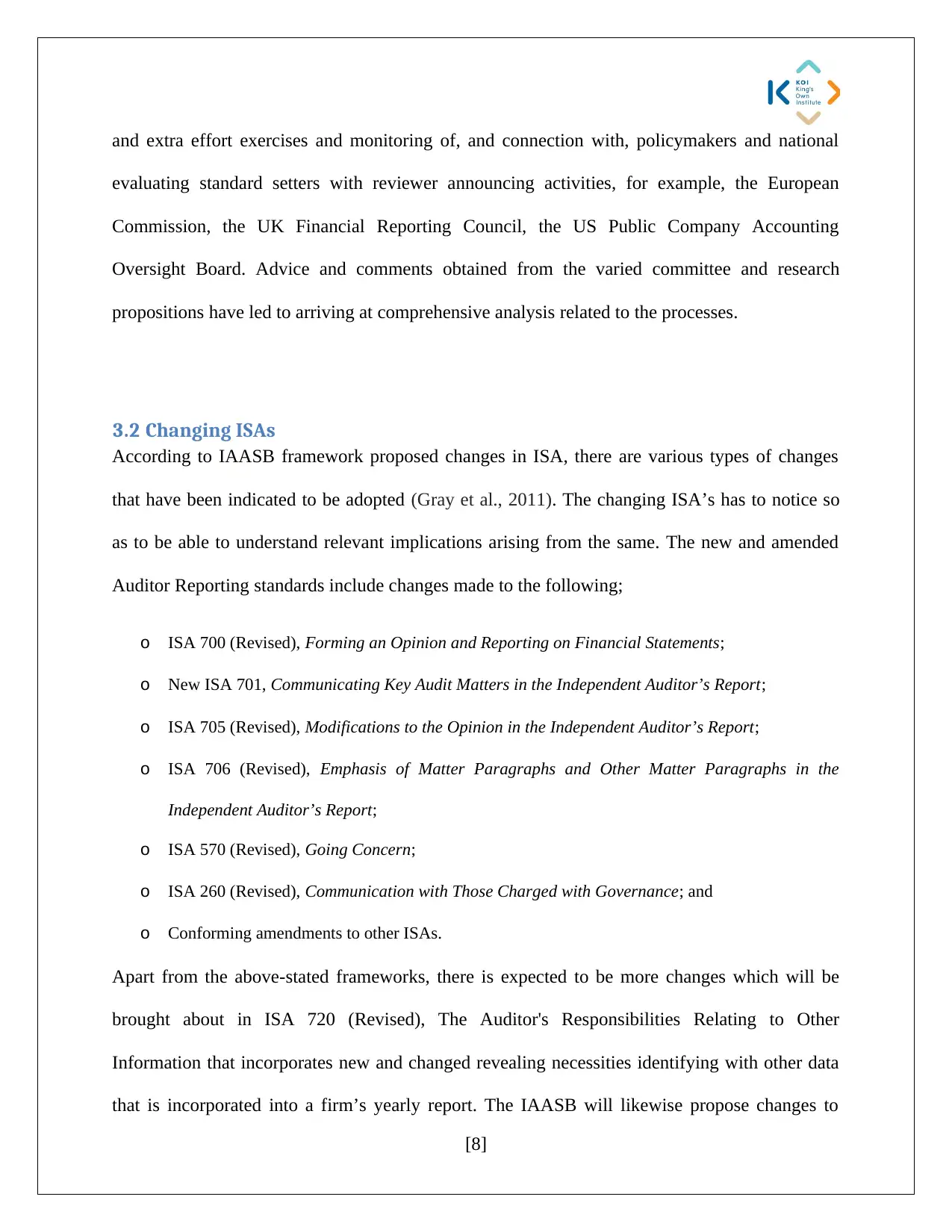
and extra effort exercises and monitoring of, and connection with, policymakers and national
evaluating standard setters with reviewer announcing activities, for example, the European
Commission, the UK Financial Reporting Council, the US Public Company Accounting
Oversight Board. Advice and comments obtained from the varied committee and research
propositions have led to arriving at comprehensive analysis related to the processes.
3.2 Changing ISAs
According to IAASB framework proposed changes in ISA, there are various types of changes
that have been indicated to be adopted (Gray et al., 2011). The changing ISA’s has to notice so
as to be able to understand relevant implications arising from the same. The new and amended
Auditor Reporting standards include changes made to the following;
o ISA 700 (Revised), Forming an Opinion and Reporting on Financial Statements;
o New ISA 701, Communicating Key Audit Matters in the Independent Auditor’s Report;
o ISA 705 (Revised), Modifications to the Opinion in the Independent Auditor’s Report;
o ISA 706 (Revised), Emphasis of Matter Paragraphs and Other Matter Paragraphs in the
Independent Auditor’s Report;
o ISA 570 (Revised), Going Concern;
o ISA 260 (Revised), Communication with Those Charged with Governance; and
o Conforming amendments to other ISAs.
Apart from the above-stated frameworks, there is expected to be more changes which will be
brought about in ISA 720 (Revised), The Auditor's Responsibilities Relating to Other
Information that incorporates new and changed revealing necessities identifying with other data
that is incorporated into a firm’s yearly report. The IAASB will likewise propose changes to
[8]
evaluating standard setters with reviewer announcing activities, for example, the European
Commission, the UK Financial Reporting Council, the US Public Company Accounting
Oversight Board. Advice and comments obtained from the varied committee and research
propositions have led to arriving at comprehensive analysis related to the processes.
3.2 Changing ISAs
According to IAASB framework proposed changes in ISA, there are various types of changes
that have been indicated to be adopted (Gray et al., 2011). The changing ISA’s has to notice so
as to be able to understand relevant implications arising from the same. The new and amended
Auditor Reporting standards include changes made to the following;
o ISA 700 (Revised), Forming an Opinion and Reporting on Financial Statements;
o New ISA 701, Communicating Key Audit Matters in the Independent Auditor’s Report;
o ISA 705 (Revised), Modifications to the Opinion in the Independent Auditor’s Report;
o ISA 706 (Revised), Emphasis of Matter Paragraphs and Other Matter Paragraphs in the
Independent Auditor’s Report;
o ISA 570 (Revised), Going Concern;
o ISA 260 (Revised), Communication with Those Charged with Governance; and
o Conforming amendments to other ISAs.
Apart from the above-stated frameworks, there is expected to be more changes which will be
brought about in ISA 720 (Revised), The Auditor's Responsibilities Relating to Other
Information that incorporates new and changed revealing necessities identifying with other data
that is incorporated into a firm’s yearly report. The IAASB will likewise propose changes to
[8]
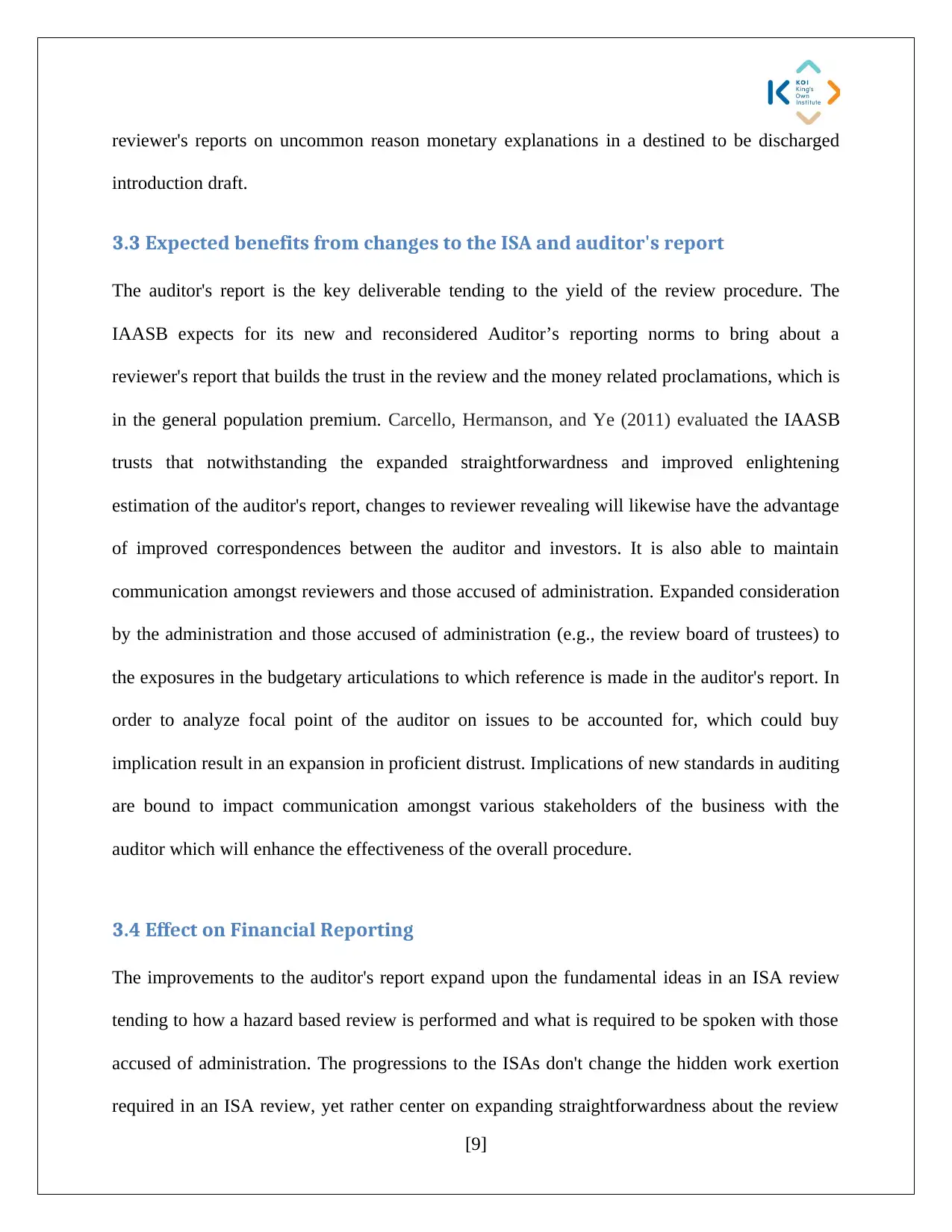
reviewer's reports on uncommon reason monetary explanations in a destined to be discharged
introduction draft.
3.3 Expected benefits from changes to the ISA and auditor's report
The auditor's report is the key deliverable tending to the yield of the review procedure. The
IAASB expects for its new and reconsidered Auditor’s reporting norms to bring about a
reviewer's report that builds the trust in the review and the money related proclamations, which is
in the general population premium. Carcello, Hermanson, and Ye (2011) evaluated the IAASB
trusts that notwithstanding the expanded straightforwardness and improved enlightening
estimation of the auditor's report, changes to reviewer revealing will likewise have the advantage
of improved correspondences between the auditor and investors. It is also able to maintain
communication amongst reviewers and those accused of administration. Expanded consideration
by the administration and those accused of administration (e.g., the review board of trustees) to
the exposures in the budgetary articulations to which reference is made in the auditor's report. In
order to analyze focal point of the auditor on issues to be accounted for, which could buy
implication result in an expansion in proficient distrust. Implications of new standards in auditing
are bound to impact communication amongst various stakeholders of the business with the
auditor which will enhance the effectiveness of the overall procedure.
3.4 Effect on Financial Reporting
The improvements to the auditor's report expand upon the fundamental ideas in an ISA review
tending to how a hazard based review is performed and what is required to be spoken with those
accused of administration. The progressions to the ISAs don't change the hidden work exertion
required in an ISA review, yet rather center on expanding straightforwardness about the review
[9]
introduction draft.
3.3 Expected benefits from changes to the ISA and auditor's report
The auditor's report is the key deliverable tending to the yield of the review procedure. The
IAASB expects for its new and reconsidered Auditor’s reporting norms to bring about a
reviewer's report that builds the trust in the review and the money related proclamations, which is
in the general population premium. Carcello, Hermanson, and Ye (2011) evaluated the IAASB
trusts that notwithstanding the expanded straightforwardness and improved enlightening
estimation of the auditor's report, changes to reviewer revealing will likewise have the advantage
of improved correspondences between the auditor and investors. It is also able to maintain
communication amongst reviewers and those accused of administration. Expanded consideration
by the administration and those accused of administration (e.g., the review board of trustees) to
the exposures in the budgetary articulations to which reference is made in the auditor's report. In
order to analyze focal point of the auditor on issues to be accounted for, which could buy
implication result in an expansion in proficient distrust. Implications of new standards in auditing
are bound to impact communication amongst various stakeholders of the business with the
auditor which will enhance the effectiveness of the overall procedure.
3.4 Effect on Financial Reporting
The improvements to the auditor's report expand upon the fundamental ideas in an ISA review
tending to how a hazard based review is performed and what is required to be spoken with those
accused of administration. The progressions to the ISAs don't change the hidden work exertion
required in an ISA review, yet rather center on expanding straightforwardness about the review
[9]
⊘ This is a preview!⊘
Do you want full access?
Subscribe today to unlock all pages.

Trusted by 1+ million students worldwide
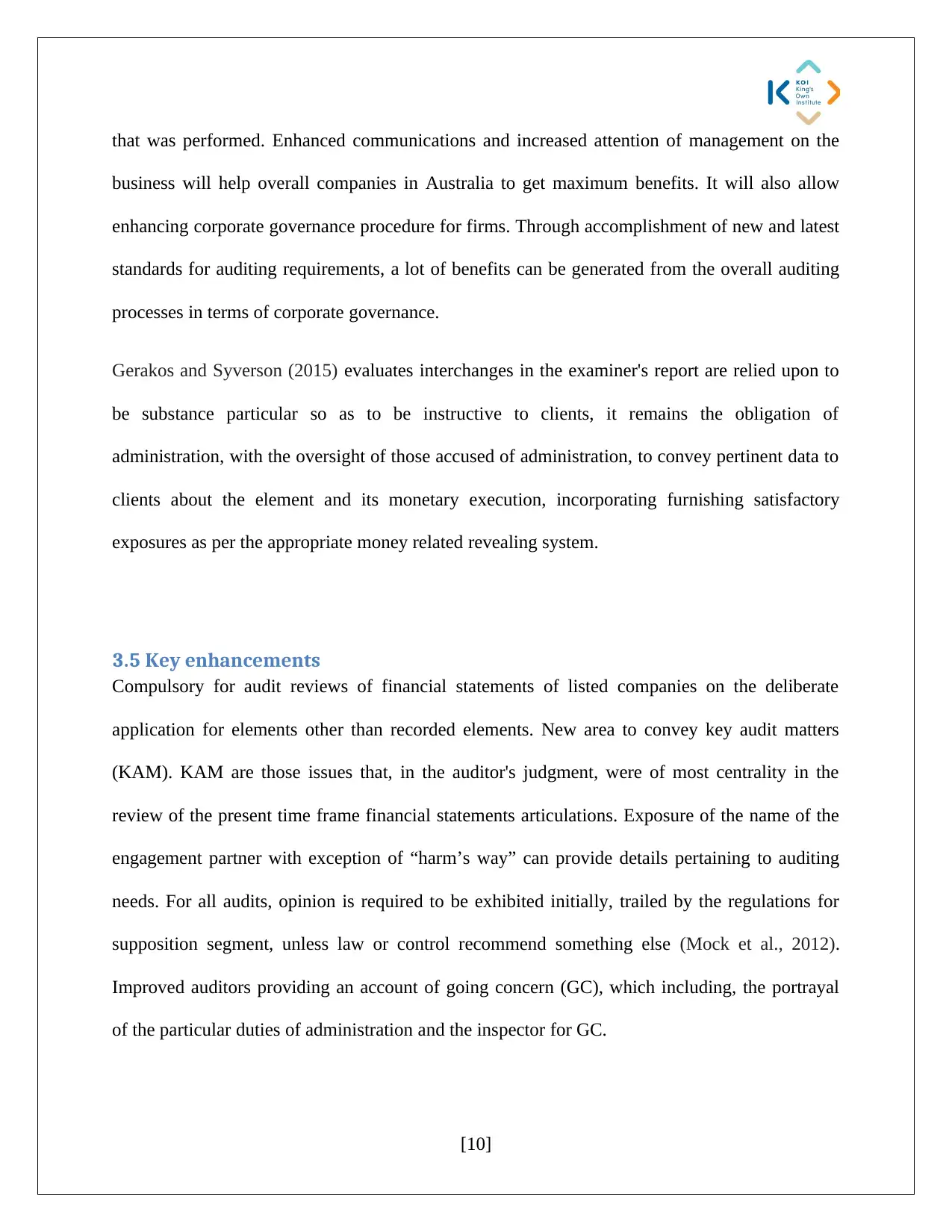
that was performed. Enhanced communications and increased attention of management on the
business will help overall companies in Australia to get maximum benefits. It will also allow
enhancing corporate governance procedure for firms. Through accomplishment of new and latest
standards for auditing requirements, a lot of benefits can be generated from the overall auditing
processes in terms of corporate governance.
Gerakos and Syverson (2015) evaluates interchanges in the examiner's report are relied upon to
be substance particular so as to be instructive to clients, it remains the obligation of
administration, with the oversight of those accused of administration, to convey pertinent data to
clients about the element and its monetary execution, incorporating furnishing satisfactory
exposures as per the appropriate money related revealing system.
3.5 Key enhancements
Compulsory for audit reviews of financial statements of listed companies on the deliberate
application for elements other than recorded elements. New area to convey key audit matters
(KAM). KAM are those issues that, in the auditor's judgment, were of most centrality in the
review of the present time frame financial statements articulations. Exposure of the name of the
engagement partner with exception of “harm’s way” can provide details pertaining to auditing
needs. For all audits, opinion is required to be exhibited initially, trailed by the regulations for
supposition segment, unless law or control recommend something else (Mock et al., 2012).
Improved auditors providing an account of going concern (GC), which including, the portrayal
of the particular duties of administration and the inspector for GC.
[10]
business will help overall companies in Australia to get maximum benefits. It will also allow
enhancing corporate governance procedure for firms. Through accomplishment of new and latest
standards for auditing requirements, a lot of benefits can be generated from the overall auditing
processes in terms of corporate governance.
Gerakos and Syverson (2015) evaluates interchanges in the examiner's report are relied upon to
be substance particular so as to be instructive to clients, it remains the obligation of
administration, with the oversight of those accused of administration, to convey pertinent data to
clients about the element and its monetary execution, incorporating furnishing satisfactory
exposures as per the appropriate money related revealing system.
3.5 Key enhancements
Compulsory for audit reviews of financial statements of listed companies on the deliberate
application for elements other than recorded elements. New area to convey key audit matters
(KAM). KAM are those issues that, in the auditor's judgment, were of most centrality in the
review of the present time frame financial statements articulations. Exposure of the name of the
engagement partner with exception of “harm’s way” can provide details pertaining to auditing
needs. For all audits, opinion is required to be exhibited initially, trailed by the regulations for
supposition segment, unless law or control recommend something else (Mock et al., 2012).
Improved auditors providing an account of going concern (GC), which including, the portrayal
of the particular duties of administration and the inspector for GC.
[10]
Paraphrase This Document
Need a fresh take? Get an instant paraphrase of this document with our AI Paraphraser
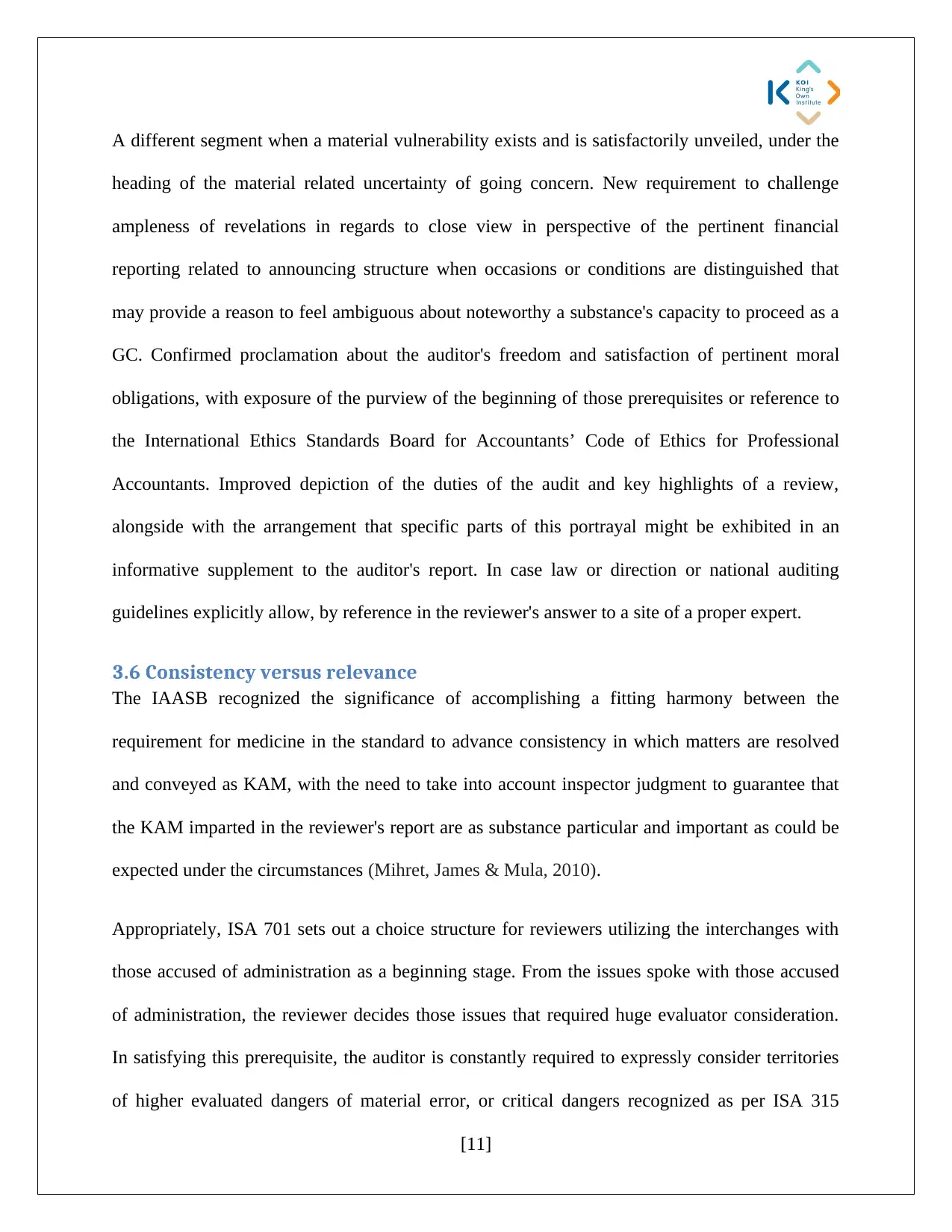
A different segment when a material vulnerability exists and is satisfactorily unveiled, under the
heading of the material related uncertainty of going concern. New requirement to challenge
ampleness of revelations in regards to close view in perspective of the pertinent financial
reporting related to announcing structure when occasions or conditions are distinguished that
may provide a reason to feel ambiguous about noteworthy a substance's capacity to proceed as a
GC. Confirmed proclamation about the auditor's freedom and satisfaction of pertinent moral
obligations, with exposure of the purview of the beginning of those prerequisites or reference to
the International Ethics Standards Board for Accountants’ Code of Ethics for Professional
Accountants. Improved depiction of the duties of the audit and key highlights of a review,
alongside with the arrangement that specific parts of this portrayal might be exhibited in an
informative supplement to the auditor's report. In case law or direction or national auditing
guidelines explicitly allow, by reference in the reviewer's answer to a site of a proper expert.
3.6 Consistency versus relevance
The IAASB recognized the significance of accomplishing a fitting harmony between the
requirement for medicine in the standard to advance consistency in which matters are resolved
and conveyed as KAM, with the need to take into account inspector judgment to guarantee that
the KAM imparted in the reviewer's report are as substance particular and important as could be
expected under the circumstances (Mihret, James & Mula, 2010).
Appropriately, ISA 701 sets out a choice structure for reviewers utilizing the interchanges with
those accused of administration as a beginning stage. From the issues spoke with those accused
of administration, the reviewer decides those issues that required huge evaluator consideration.
In satisfying this prerequisite, the auditor is constantly required to expressly consider territories
of higher evaluated dangers of material error, or critical dangers recognized as per ISA 315
[11]
heading of the material related uncertainty of going concern. New requirement to challenge
ampleness of revelations in regards to close view in perspective of the pertinent financial
reporting related to announcing structure when occasions or conditions are distinguished that
may provide a reason to feel ambiguous about noteworthy a substance's capacity to proceed as a
GC. Confirmed proclamation about the auditor's freedom and satisfaction of pertinent moral
obligations, with exposure of the purview of the beginning of those prerequisites or reference to
the International Ethics Standards Board for Accountants’ Code of Ethics for Professional
Accountants. Improved depiction of the duties of the audit and key highlights of a review,
alongside with the arrangement that specific parts of this portrayal might be exhibited in an
informative supplement to the auditor's report. In case law or direction or national auditing
guidelines explicitly allow, by reference in the reviewer's answer to a site of a proper expert.
3.6 Consistency versus relevance
The IAASB recognized the significance of accomplishing a fitting harmony between the
requirement for medicine in the standard to advance consistency in which matters are resolved
and conveyed as KAM, with the need to take into account inspector judgment to guarantee that
the KAM imparted in the reviewer's report are as substance particular and important as could be
expected under the circumstances (Mihret, James & Mula, 2010).
Appropriately, ISA 701 sets out a choice structure for reviewers utilizing the interchanges with
those accused of administration as a beginning stage. From the issues spoke with those accused
of administration, the reviewer decides those issues that required huge evaluator consideration.
In satisfying this prerequisite, the auditor is constantly required to expressly consider territories
of higher evaluated dangers of material error, or critical dangers recognized as per ISA 315
[11]
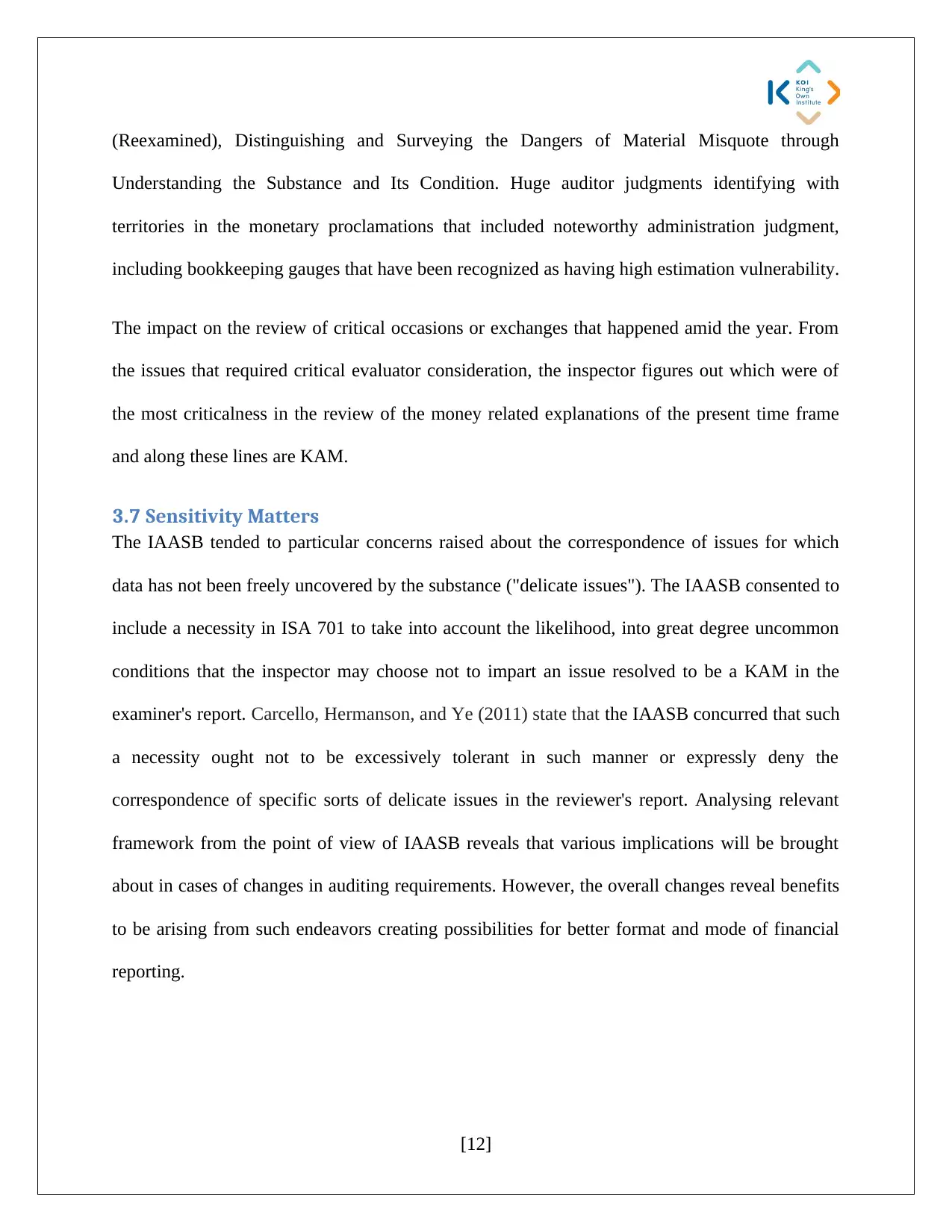
(Reexamined), Distinguishing and Surveying the Dangers of Material Misquote through
Understanding the Substance and Its Condition. Huge auditor judgments identifying with
territories in the monetary proclamations that included noteworthy administration judgment,
including bookkeeping gauges that have been recognized as having high estimation vulnerability.
The impact on the review of critical occasions or exchanges that happened amid the year. From
the issues that required critical evaluator consideration, the inspector figures out which were of
the most criticalness in the review of the money related explanations of the present time frame
and along these lines are KAM.
3.7 Sensitivity Matters
The IAASB tended to particular concerns raised about the correspondence of issues for which
data has not been freely uncovered by the substance ("delicate issues"). The IAASB consented to
include a necessity in ISA 701 to take into account the likelihood, into great degree uncommon
conditions that the inspector may choose not to impart an issue resolved to be a KAM in the
examiner's report. Carcello, Hermanson, and Ye (2011) state that the IAASB concurred that such
a necessity ought not to be excessively tolerant in such manner or expressly deny the
correspondence of specific sorts of delicate issues in the reviewer's report. Analysing relevant
framework from the point of view of IAASB reveals that various implications will be brought
about in cases of changes in auditing requirements. However, the overall changes reveal benefits
to be arising from such endeavors creating possibilities for better format and mode of financial
reporting.
[12]
Understanding the Substance and Its Condition. Huge auditor judgments identifying with
territories in the monetary proclamations that included noteworthy administration judgment,
including bookkeeping gauges that have been recognized as having high estimation vulnerability.
The impact on the review of critical occasions or exchanges that happened amid the year. From
the issues that required critical evaluator consideration, the inspector figures out which were of
the most criticalness in the review of the money related explanations of the present time frame
and along these lines are KAM.
3.7 Sensitivity Matters
The IAASB tended to particular concerns raised about the correspondence of issues for which
data has not been freely uncovered by the substance ("delicate issues"). The IAASB consented to
include a necessity in ISA 701 to take into account the likelihood, into great degree uncommon
conditions that the inspector may choose not to impart an issue resolved to be a KAM in the
examiner's report. Carcello, Hermanson, and Ye (2011) state that the IAASB concurred that such
a necessity ought not to be excessively tolerant in such manner or expressly deny the
correspondence of specific sorts of delicate issues in the reviewer's report. Analysing relevant
framework from the point of view of IAASB reveals that various implications will be brought
about in cases of changes in auditing requirements. However, the overall changes reveal benefits
to be arising from such endeavors creating possibilities for better format and mode of financial
reporting.
[12]
⊘ This is a preview!⊘
Do you want full access?
Subscribe today to unlock all pages.

Trusted by 1+ million students worldwide
1 out of 24
Related Documents
Your All-in-One AI-Powered Toolkit for Academic Success.
+13062052269
info@desklib.com
Available 24*7 on WhatsApp / Email
![[object Object]](/_next/static/media/star-bottom.7253800d.svg)
Unlock your academic potential
Copyright © 2020–2025 A2Z Services. All Rights Reserved. Developed and managed by ZUCOL.





